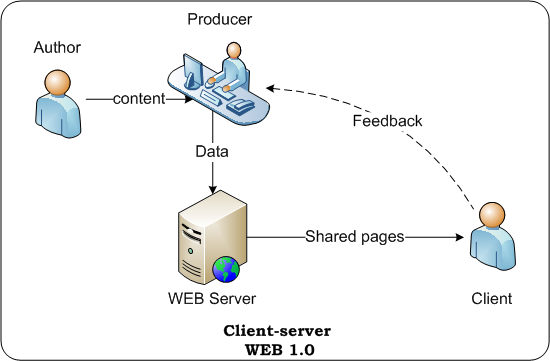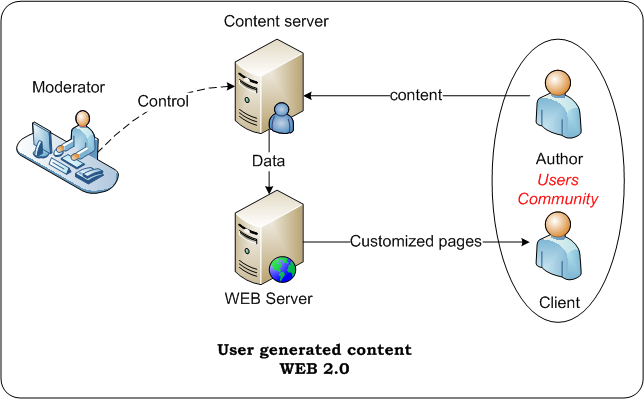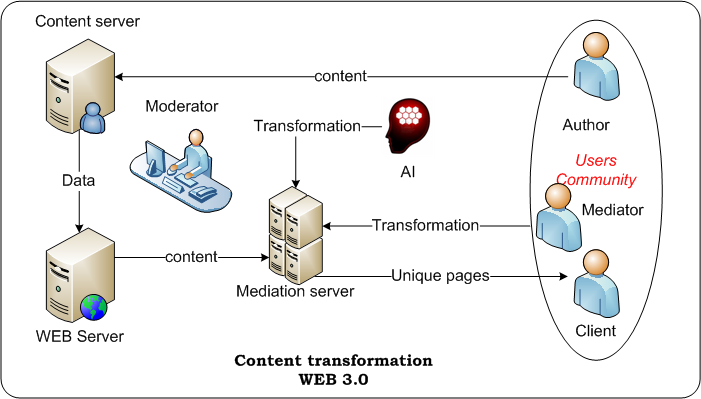WEB 3.0
for more than a year I'm working on an interesting and controversial project in the field of e-commerce. Working on a very special case of global problems, and recurrent misunderstanding of the results, even among experienced professionals has led to the idea to create a stock of accumulated ideas.
In my generalization I threaten neither more nor less than the definition of WEB 3.0! After the success of the principles of WEB 2.0 it would be strange if the label 3.0 is not pilfered for their definitions of various visionaries. However, in their attempts they drew the typical "better 2.0". Attempt to increment the version number with the help of such epithets as "beautiful", "professional" is nothing more than a marketing shuck!
Example of such stuff — current version numbering of Firefox. I use it rarely, only for viewing layout for new versions of the projects. When each run is what changed the version and swapped some of the buttons in the menu.
The recognition of new versions can only be justified for a technological leap in key areas for web services — creation and handling of information (content). This leap cannot be "more beautiful" or "more professional", it can only be radically different technologically.
My belief is that the key feature of WEB 3.0 will be "transformation content" that will change not only the principles of design and development of web applications, but also the concept of copyright, and will lead to the transformation of the business models of existing services.
I wanted to argue? Then welcome under kat!
Before you look into the future, you need to deal with what we have.

The good old Web, which has created created the Foundation and all the terminology on the basis of the concepts of client — server. There is information consumer client, is a manufacturer of information — a professional journalist (writer, Director, producer, archive). The producer decides what might be interesting to the consumer. The consumer can write your opinion by e-mail, and often simply vote with their feet and leaving on another resource.
In 2000, I worked as a news gleization a computer website. Every bit of news, I read about 1,000 visitors, but the response e-mail was a rarity and a real treat! Comforted that writers could do to rely on recognition only after death
Electronic libraries, news sites, online Newspapers are the classic examples of old WEB services.
With the development and expansion of the world wide web had absorbed all new users. One of the first network came educated professionals, the so-called creative class. They began to create communities of interest — community that has formed around the web-forums. These active groups could not accept the fate of passive content consumers and a revolution — created WEB 2.0.

The key difference of the new version of the Web was the principle of content creation, instead of the tyrannical editor-in-Chief, a low — profile moderator. In the best projects moderator became as invisible as a UFO.
Successful examples vebdvanol projects can be called a LiveJournal, Wikipedia and of course the much-loved Habrahabr. The essence of the idea of community become social networks.
The existing growth of the global Internet is fueled by two factors:
The first trend objectively dictates the necessity of creation of personalized versions of the display of the various sites. This challenge even spawned the term content adaptation, defined as way transformation content to adapt themselves to the technical capabilities of the playback device.
The second trend leads to the emergence of "cultural adaptation", the most obvious option which is a translation into a foreign language. However, there are other adaptation options, such as filtering obscene content. The most famous example of this adaptation of the great Chinese fairwa.
How to look like a technology that meets the challenges of WEB 3.0?
A small comment pseudo-liberals who will certainly excited at the mention of Chinese censorship. In my interpretation of the WEB3.0 does not cut and does not filter any of the original information instead creates new projection new website with existing content. Thus, instead of limiting or separating the Internet it creates another degree of freedom, like the freedom to receive and read information in that language accessible to the reader, and with those restrictions it deems acceptable. New projection honestly and openly competes with the original and other variants of interpretation.
I would venture to depict it in the diagram:

In full accordance with the complexity of the modeled reality in the new scheme is an intermediate layer which I have termed Mediation (Intermediation). The term has rich experience in the field of telecommunications and law, and fully reveals the essence of the action. Mediation server based on the source of the content (text) creates a different projection of reality. This can be as the translation of magazine articles from English into Chinese, and correction of the obscene blog's Theme of Lebedev in Russian literature, or language accessible to younger students.
Mediation server can be operated by impact of machine intelligence, for example, using the Summly (innovative startup processing of the web of text created by a 15 year old British Prodigy, who has invested 89-year-old Chinese billionaire) or ABBYY Compreno.
An alternative method of formation of Mediation with mediators whose work is based on crowdsourcing and Web2 scoring.0.
Boiled brains? Not a problem! Leave the Hi-tech slang and try to draw your finger Wikipedia 3.0.
the
Anyone who has read the article up to this place — a hero who deserves to be rewarded!
Dear Abrowser! Imagine that the good Genie will fulfill one your wish is going to launch Web 3.0, but with the condition! It should be a wonderful, bright and fun project. To anyone who went to the page of the project immediately exclaimed, "Wow, cool!" and sent the link to your friends 33.
Below is a partial list of ideas to review of a grumpy Genie.
When the Genie disappeared, was found some strange entries: Nginx, Lua, PCRE, Redis NoSQL, persistent cache, hash map, key-value, 10K requests. Looks like some sort of weird spells!
Article based on information from habrahabr.ru
In my generalization I threaten neither more nor less than the definition of WEB 3.0! After the success of the principles of WEB 2.0 it would be strange if the label 3.0 is not pilfered for their definitions of various visionaries. However, in their attempts they drew the typical "better 2.0". Attempt to increment the version number with the help of such epithets as "beautiful", "professional" is nothing more than a marketing shuck!
Example of such stuff — current version numbering of Firefox. I use it rarely, only for viewing layout for new versions of the projects. When each run is what changed the version and swapped some of the buttons in the menu.
The recognition of new versions can only be justified for a technological leap in key areas for web services — creation and handling of information (content). This leap cannot be "more beautiful" or "more professional", it can only be radically different technologically.
My belief is that the key feature of WEB 3.0 will be "transformation content" that will change not only the principles of design and development of web applications, but also the concept of copyright, and will lead to the transformation of the business models of existing services.
I wanted to argue? Then welcome under kat!
Before you look into the future, you need to deal with what we have.
WEB 1.0

The good old Web, which has created created the Foundation and all the terminology on the basis of the concepts of client — server. There is information consumer client, is a manufacturer of information — a professional journalist (writer, Director, producer, archive). The producer decides what might be interesting to the consumer. The consumer can write your opinion by e-mail, and often simply vote with their feet and leaving on another resource.
In 2000, I worked as a news gleization a computer website. Every bit of news, I read about 1,000 visitors, but the response e-mail was a rarity and a real treat! Comforted that writers could do to rely on recognition only after death
Electronic libraries, news sites, online Newspapers are the classic examples of old WEB services.
WEB 2.0
With the development and expansion of the world wide web had absorbed all new users. One of the first network came educated professionals, the so-called creative class. They began to create communities of interest — community that has formed around the web-forums. These active groups could not accept the fate of passive content consumers and a revolution — created WEB 2.0.

The key difference of the new version of the Web was the principle of content creation, instead of the tyrannical editor-in-Chief, a low — profile moderator. In the best projects moderator became as invisible as a UFO.
Successful examples vebdvanol projects can be called a LiveJournal, Wikipedia and of course the much-loved Habrahabr. The essence of the idea of community become social networks.
WEB 3.0
The existing growth of the global Internet is fueled by two factors:
- rapid growth of subscribers in developing and underdeveloped countries, with strong cultural differences.
the increasing number of mobile devices to access the network the
The first trend objectively dictates the necessity of creation of personalized versions of the display of the various sites. This challenge even spawned the term content adaptation, defined as way transformation content to adapt themselves to the technical capabilities of the playback device.
The second trend leads to the emergence of "cultural adaptation", the most obvious option which is a translation into a foreign language. However, there are other adaptation options, such as filtering obscene content. The most famous example of this adaptation of the great Chinese fairwa.
How to look like a technology that meets the challenges of WEB 3.0?
A small comment pseudo-liberals who will certainly excited at the mention of Chinese censorship. In my interpretation of the WEB3.0 does not cut and does not filter any of the original information instead creates new projection new website with existing content. Thus, instead of limiting or separating the Internet it creates another degree of freedom, like the freedom to receive and read information in that language accessible to the reader, and with those restrictions it deems acceptable. New projection honestly and openly competes with the original and other variants of interpretation.
I would venture to depict it in the diagram:

In full accordance with the complexity of the modeled reality in the new scheme is an intermediate layer which I have termed Mediation (Intermediation). The term has rich experience in the field of telecommunications and law, and fully reveals the essence of the action. Mediation server based on the source of the content (text) creates a different projection of reality. This can be as the translation of magazine articles from English into Chinese, and correction of the obscene blog's Theme of Lebedev in Russian literature, or language accessible to younger students.
Mediation server can be operated by impact of machine intelligence, for example, using the Summly (innovative startup processing of the web of text created by a 15 year old British Prodigy, who has invested 89-year-old Chinese billionaire) or ABBYY Compreno.
An alternative method of formation of Mediation with mediators whose work is based on crowdsourcing and Web2 scoring.0.
Boiled brains? Not a problem! Leave the Hi-tech slang and try to draw your finger Wikipedia 3.0.
Wikipedia 3.0 — what it could be?
the
-
the
- To a new Wikipedia no longer need separate national sites. The uniform structure of the encyclopedia is translated to varying degrees into other languages. Missing translation creates a machine intelligence. Machine translation is proofed by native speakers resulting in the learning algorithm. the
- l'ourcq is no longer a separate encyclopedia, its projection inside. As well as many other new projections. the
- Projection Wikipedia is available for any device groups — for cell phones with 80-character screen or readers of Twitter.
- Projection are formed of the most popular edits on them and vote crowd of editors. the
- Projection formed on the fly by interpolating the corrections for different periods of time — want to have the most current, if you want to get the commend over the last year. the
- no More wars editors — any projection has a right to life if you read it and vote for it. Old projection disappear on the principle of the least used.
Any visitor can either read the selected projection, or to enable crowd-revision of the projection/article/paragraph and vote for someone else's proofreading. Either can become an editor and make your changes. the
Cake
Anyone who has read the article up to this place — a hero who deserves to be rewarded!
Dear Abrowser! Imagine that the good Genie will fulfill one your wish is going to launch Web 3.0, but with the condition! It should be a wonderful, bright and fun project. To anyone who went to the page of the project immediately exclaimed, "Wow, cool!" and sent the link to your friends 33.
Below is a partial list of ideas to review of a grumpy Genie.
-
the
- to Make learn the karma of the authors, as on habré (not enough money for project server hosting) the
- to Make the automated translation LiveJournal the blog Lebedev to the literary language (will learn Boris Akunin) the
- . Translate into English ( digg still shorter) the
- to Enable Anonymus the opportunity to vote for karma on habré (the world is not yet ready) the
- to Take some sort of jobsit, Yes, fasten it to the tape with comments and rating to be able to cut the truth uterus (hantim.ru — simple and tasteful, like the Genie!)
When the Genie disappeared, was found some strange entries: Nginx, Lua, PCRE, Redis NoSQL, persistent cache, hash map, key-value, 10K requests. Looks like some sort of weird spells!
Комментарии
Отправить комментарий